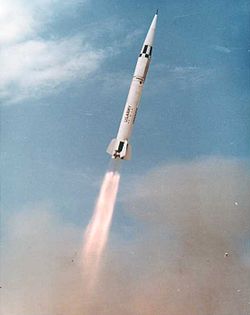MGM-29 Sergeant
| MGM-29 Sergeant | |
|---|---|

Launch of a MGM-29
|
|
| Type | Tactical ballistic missile |
| Place of origin | United States |
| Service history | |
| In service | 1962-1979 |
| Used by |
United States Army German Army |
| Production history | |
| Designer | Jet Propulsion Laboratory |
| Designed | 1955 |
| Manufacturer | Sperry Utah |
| No. built | ~500 |
| Specifications | |
| Weight | 10,100 lb (4,600 kg) |
| Length | 34 ft 6 in (10.52 m) |
| Diameter | 31 in (79 cm) |
|
|
|
| Warhead | W52 (M65) nuclear |
| Blast yield | 200 kt |
|
|
|
| Engine | Thiokol XM100 200 kN (45,000 lbf) |
| Propellant | Solid fuel |
|
Operational
range |
75 nmi (139 km) |
| Boost time | 34 sec |
|
Guidance
system |
Inertial |
The MGM-29 Sergeant was an American short-range, solid fuel, surface-to-surface missile developed at the Jet Propulsion Laboratory. The missiles were built by Sperry Utah Company.
Activated by the US Army in 1962 to replace the MGM-5 Corporal, it was deployed in Europe and South Korea by 1963, carrying the W52 (M65) nuclear warhead or alternatively one of high explosives. A biological warhead, the M210, was standardized but not procured, and there was also a chemical variant, the M212 which had not attained standardization. It was replaced by the MGM-52 Lance and the last US Army battalion was deactivated in 1977. Sergeant Missile Systems were usually assigned to the field army with the mission of "general support to a corps"
Operation of the Sergeant was recognized to be an interim stage in the development of battlefield missiles. It avoided the Corporal's liquid-fuel-handling drawbacks, but still requiring extensive setup and checkout before launch, together with a train of semi-trailer support vehicles. More advanced missiles, such as the contemporary Blue Water and later Lance, would reduce setup time.
The Sergeant had a takeoff thrust of 200 kilonewtons (45,000 lbf), a takeoff weight of 4,530 kilograms (9,990 lb), a diameter of 790 millimetres (31 in), a length of 10.52 metres (34.5 ft) and a fin span of 1.80 metres (5 ft 11 in). The Sergeant missile had a minimum range of 40 kilometres (25 mi), and a maximum range of 135 kilometres (84 mi).
The Sergeant was used as the second stage of the Scout satellite launcher, and clusters of Sergeant-derived rockets were used in the second and third stages of the Jupiter-C sounding rocket and used in the second, third, and fourth stages of the Juno I and Juno II launch vehicles.
...
Wikipedia
